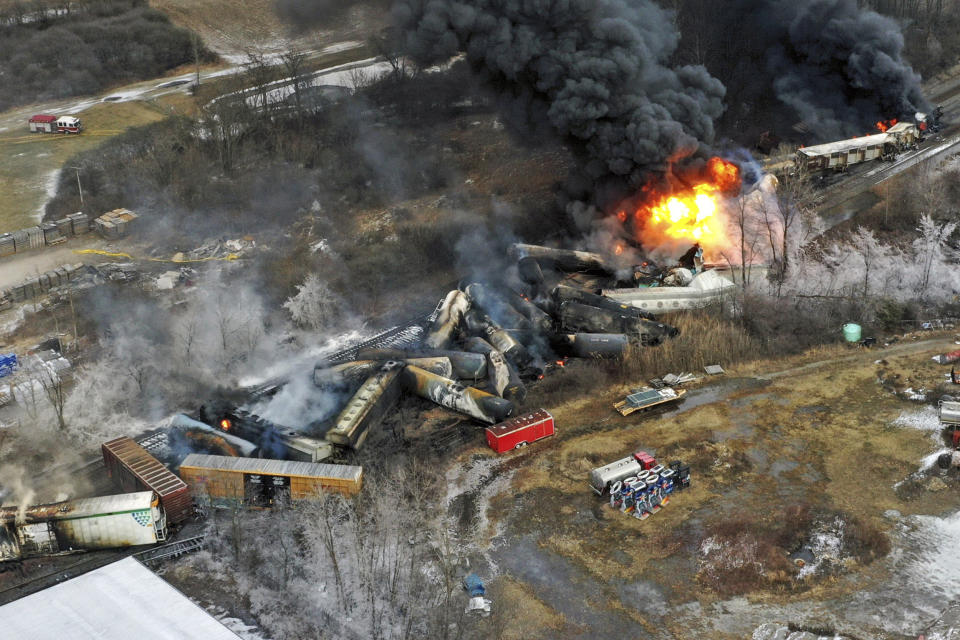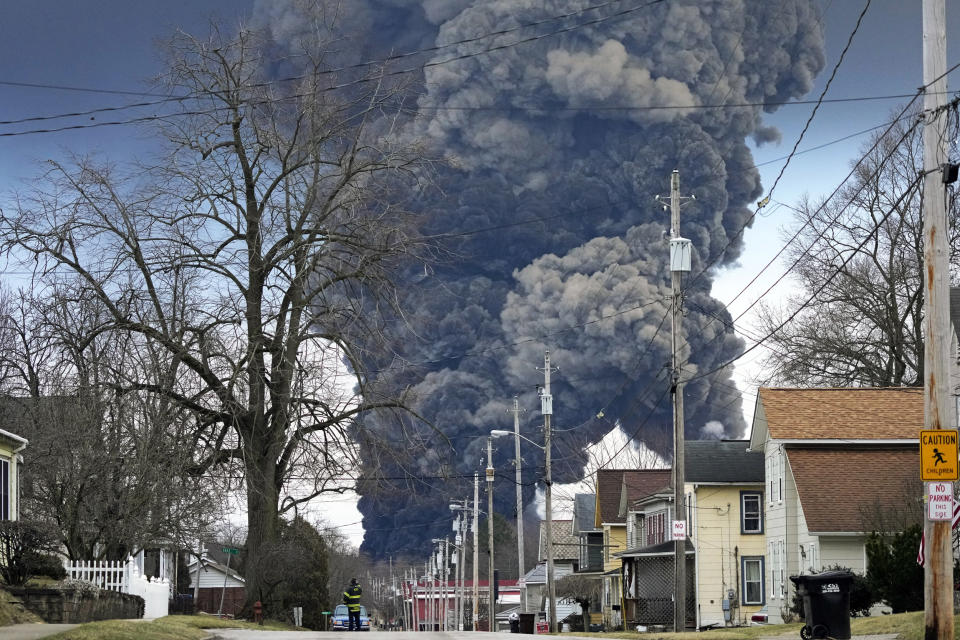Ohio derailment: What chemicals spilled, and how could they affect residents?
EAST PALESTINE, Ohio — The chemicals that spilled and were later burned near East Palestine, Ohio, after the Feb. 3 train derailment have the kinds of names that bring back visions of high school chemistry: vinyl chloride, butyl acrylate and isobutylene.
Scientists know the names well, along with the harms these chemicals can cause to the environment and human health — from irritation of the eyes and skin to breathing difficulties and cancer — raising major concerns about exposure and contamination in the wake of the incident.
The burning of some chemicals in the aftermath of the disaster — a decision made by authorities to avoid an explosion — is also complicating an already fraught situation that has sparked fears of potential health impact beyond eastern Ohio.
The threats of the chemicals vary. Residents of East Palestine have been told it’s safe to return home, but questions remain about lingering exposure in the air, water and soil, even if at low levels.

Five toxic chemicals have been identified around the derailment site:
Vinyl chloride: A known carcinogen, vinyl chloride is a colorless and flammable gas that is used to produce polyvinyl chloride (PVC) plastic for packaging materials and a range of electronic, medical and construction products. Symptoms of exposure include drowsiness, disorientation, numbness and tingling of the extremities and nausea, according to the Centers for Disease Control and Prevention. The chemical can also irritate the eyes and skin.
Butyl acrylate: A colorless liquid with a strong, fruity odor that is often used to produce various plastics, polymers, coatings and resins. Exposure to the chemical can cause irritation to the eyes and skin, rashes and breathing difficulties, according to the CDC.
Isobutylene: A colorless gas that is used to produce plastics, packaging materials and resins. Exposure can cause symptoms such as dizziness and headache, but a cargo manifest provided to the Environmental Protection Agency indicates that Norfolk Southern, the company that operated the train, saw “no signs of breach” with the car carrying this chemical.
Ethylene glycol and ethylhexyl acrylate: Ethylhexyl acrylate is a colorless liquid that is commonly used to produce plastics and polymers. Ethylene glycol is a synthetic compound used in inks, paint, hydraulic brake fluids and antifreeze. Both can both cause irritation of the skin and eyes, as well as sore throat and nausea with exposure at high concentrations.
More than two weeks after portions of the 150-car freight train derailed, experts say it’s not clear if officials are doing enough to assess the immediate and long-term impact these chemicals could have on human health and the environment.
“There’s been a lot of nebulous discussion about testing and safety and following the science, but there’s actually no cohesive explanation about what they did, why they did it and what they’re doing now,” said Andrew Whelton, a professor of environmental and ecological engineering at Purdue University.

Whelton said he’s especially concerned about harmful pollutants that may have been created as a byproduct of the derailment and fire. These include compounds known as dioxins that are separate from the toxic substances that were initially spilled but are produced when chemicals such as vinyl chloride are burned.
While the Environmental Protection Agency has said it will continue testing and monitoring air, water and soil in East Palestine, officials did not specify if sampling would include byproducts such as dioxins.
“Dioxins are heavy compounds that like to stick to stuff,” Whelton said. “Dioxins typically stick to the particulate matter that was created during the burn, and then can settle on to people’s properties or brought into their homes. And they can be quite toxic if ingested and inhaled.”
Dioxins are also long-lived compounds because they do not break down easily. In some cases, Whelton said, they can be present in homes or other environments for decades.
Of the chemicals that were identified at the derailment site, vinyl chloride has been the main focus.
Exposure at high doses can increase a person’s risk of liver damage or liver cancer, according to the CDC, but long-term exposure at low levels is also thought to have damaging health consequences.
Vinyl chloride is a so-called volatile organic compound that can exist in both liquid and gas forms. This means it can seep into soil and pollute groundwater, but, especially at high temperatures, it can also contaminate the air, said Juliane Beier, a hepatologist at the University of Pittsburgh who has studied the effects of vinyl chloride on animals.
“Vinyl chloride is so volatile, so within homes or other enclosed spaces, it will come out of the water due to the room temperature, or especially when the water is heated — taking showers, cooking, so on and so forth,” Beier said.
The EPA said it began testing air quality in the East Palestine area within 24 hours of the derailment and is also assisting with indoor air quality monitoring as part of a voluntary program that includes more than 550 homes. So far, the agency reported that vinyl chloride and hydrogen chloride were not detected above levels of concern.
But Mo Osman, who runs Summit Environmental Technologies, a lab that Ohio’s Columbiana County hired to analyze its water samples, said it can take time for pollutants to seep into groundwater stores.
“If a well is safe right now, we don’t know what the quality of that water is going to be in a week, a month or two months,” Osman said. “It takes time for pollution to potentially travel from the source of contamination to the individual well, so it is very important to continue sampling at a certain frequency.”

Vinyl chloride is also not the only chemical that authorities are monitoring.
Officials with the Ohio EPA said butyl acrylate was detected during sampling of the Ohio River at concentrations below 3 parts per billion. The agency said in a Feb. 16 statement that this is “well below the 560 parts per billion that the CDC considers hazardous.” State officials added that no vinyl chloride had been detected in the Ohio River at that time.
Last week, EPA Administrator Michael Regan said the agency is testing for all volatile organic chemicals and will continue to monitor air and water quality in the region.
The agency on Tuesday also announced that it would compel Norfolk Southern to pay for cleanup efforts — which include identifying and cleaning contaminated soil and water — reimburse EPA costs and participate in public meetings at the EPA’s request.
Denise Chow reported from New York City and Kenzi Abou-Sabe from East Palestine.
This article was originally published on NBCNews.com

